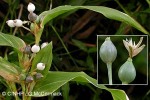Cook Islands Biodiversity Database
Species Page
Coix lacryma-jobi
PoepoeJob's Tears
Multimedia & Additional Resources
| Type | Description | Download |
| Fruit and leaves | 60KB | |
| Leaves, fruit and flower | 32KB |
General Information
Cook Islands Distribution
| Southern Group: Present Makatea: Present | ||||||||
RR |
MG |
AT |
MK |
MT |
AK |
PL |
TK |
MN |
++++ |
+++ |
++++ |
X |
- |
- |
- |
||
| Northern Group: | |||||
TN |
MH |
RK |
PK |
NS |
SW |
- |
- |
- |
- |
- |
- |
Scientific Taxonomy
Coix lacryma-jobi Linnaeus
TAXONOMY: PLANTAE; ANTHOPHYTA (=Angiospermae); LILIOPSIDA (=Monocotyledones); COMMELINIDAE; Cyperales; POACEAE
More Information
SIGNIFICANCE NOTES -
POSITIVE SIGNIFICANCE: Material (Adornment). Comments: The grey 'seeds' are used as beads for necklaces.
NEGATIVE SIGNIFICANCE: Mild invasive in swamplands.
IDENTIFICATION: Tall annual grass to 2m. LEAVES wide, flat, lancelike. FLOWERS several clusters in upper leaf-joints (=axils); each cluster on a long stalk with a grey beadlike sheath (=cupule / involucre) to 15mm; female flowers are inside the sheath, while male flowers protrude and are soon discarded. The sheath forms a hard white or grey 'seed'.
GENERAL NOTE: Cheeseman did not record this plant in May-June 1899, while Wilder recorded it in the 1920 as 'rapidly spreading along waterways, and is becoming a noxious weed. Probably accidentally introduced'. This seems to indicate that it is a Recent Introduction in the Cook Islands, as in Hawaii where Wagner et.al. record it as first noted around 1870 and first collected in 1903.
Vouchers & References
Vouchers:
None Recorded.
References:
p.1517 Wagner et al.- Flowering Plants of Hawaii
p.80 Neal - In Gardens of Hawaii
p.274 Royal Hort. Soc. Index of Garden Plants
p.1/388 A.C.Smith - Flora Vitiensis Nova
p.17 R Wilder - Flora of Rarotonga
p.392b Whistler - Ethnobotany of the Cook Islands
Data Update History (information):
zTX, zB02, zM02, zD02
Web Resources
Citation Information
McCormack, Gerald (2007) Cook Islands Biodiversity Database, Version 2007.2. Cook Islands Natural Heritage Trust, Rarotonga. Online at http://cookislands.bishopmuseum.org. ![]()
Please refer to our use policy.

